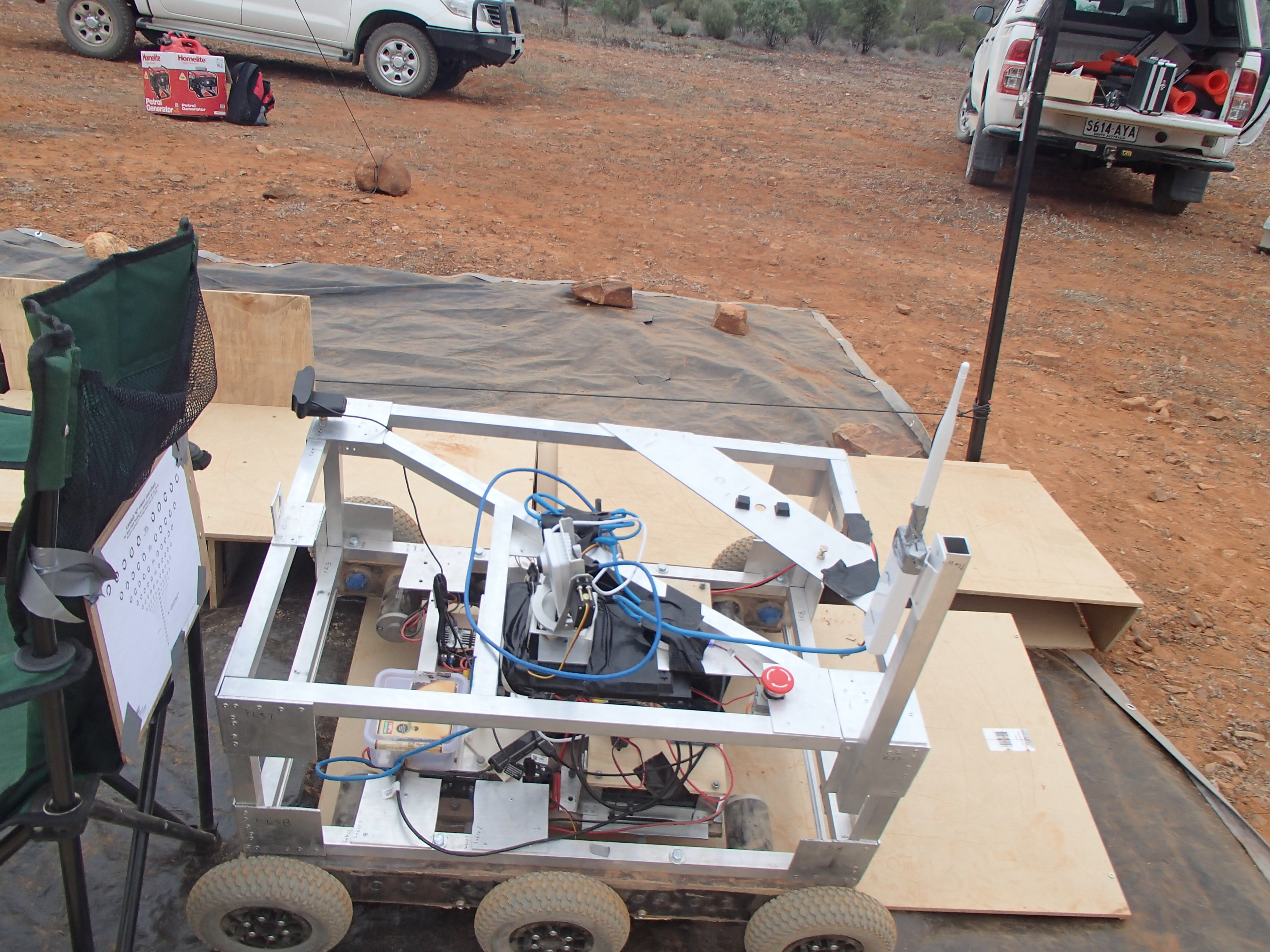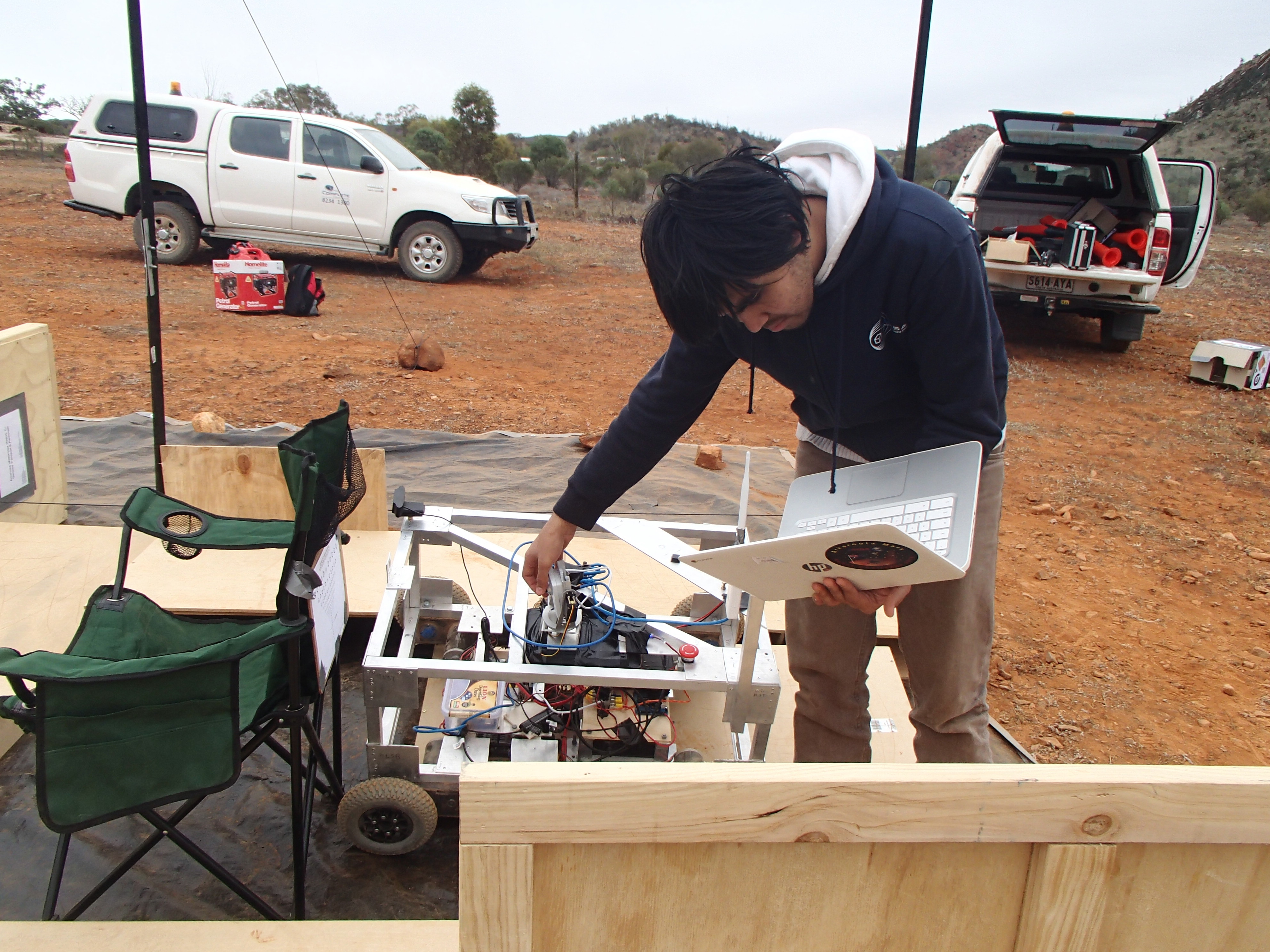Main menu
Expedition Diary
DAY 1 - Saturday 5th July, 2014
The expedition has arrived at Arkaroola Resort after early morning departure from Adelaide. The entourage of 5 vehicles stopped at Port Wakefield for breakfast, the town of Quorn for lunch, then had an afternoon stop at the settlement of Copley before arriving at Arkaroola at around 5pm. Outside Adelaide, we encounted little other traffic. We passed multiple groups of emus by the roadside during the afternoon. As we neared our destination, the roads route became increasingly dusty and the hilly landscape orange and arid, with occasional dried river beds in the valleys containing stands of massive white barked gum trees. At Arkaroola, we were soon joined by teachers Tim Wheaton and Nicci Hilton from Armidale and Steve Hobbs and his family from Canberra. The expedition is staying in Greenwood Lodge in the resort, which features a recently renovated large common room. High speed internet access is also available. After dinner in the resort restaurant, we had a group briefing session reviewing safety protocols for during out stay and also the various facilities available at Arkaroola, as well also planning our activities for the coming days.
(below left) - Arkaroola Reception and Restaurant, (below right) - Greenwood Lodge.


DAY 2 - Sunday 6th July, 2014
Our first full day was spent getting to know both the surroundings and our equipment. Expedition leader Dr Jonathan Clarke took most of the expeditioners on a tour of sites of interest in the region surrounding the Arkaroola Resort. The two analogue space suits on loan from the Victorian Space Science Education Centre in Pascoe Vale, Melbourne were unpacked and used for a preliminary space walk by Astrid Dahl and Tim Smith from Saber Astronautics. Work began on assembling the various robotic rovers that will be trialled over the coming fortnight. The day finished with a barbecue for the evening meal. Ken Silburn pointed out an overhead pass by the International Space Station, which was clearly visible in the evening sky to the north. A rich assortment of photographic and video material from the expedition is being posted on the Mars Society Australia's Facebook group, so we recommend you join the group if you haven't already in order to gain access to this. (The link is at the top right corner of this page.)
DAY 3 - Monday 7th July, 2014
The Indian rover arrived today to the joy of the Indian rover team. (It has unexpectedly been held up by Australian Customs.). Expeditioners Karl and Varun drove it up to Arkaroola from Adelaide. Most of the day was otherwise spent by the robot team formally describing and characterising each of the robots, including taking detailed measurements and other metrics. Meanwhile the first two EVA's were undertaken under the direction of the Saber expeditioners. These involved sojourns with a robotic rover in the morning, and Tim Wheaton's aerial drone in the evening. Weather conditions at Arkaroola are very cold this time of year, particularly at night.
DAY 4 - Tuesday 8th July, 2014
Our apologies for the delays in updating this diary, as the high speed internet connection at Arkaroola has been down for 24 hours, and has only just been restored. Most of today was spent assembling pitch and roll ramps on the flat plain adjacent to the Arkaroola Caravan Park for use as a test environment for mobile robots. This was an elaborate timber ramp constructed of triangular sectioned timber modules according to a very precise international standard. Some tests we're undertaken by robots using this surface during the afternoon. We have been joined by a visiting ABC journalist Eloise, who joined us on the afternoon's EVA. Rock wallabies were observed on the adjacent hill at sunset.
DAY 5 - Wednesday 9th July, 2014
The robots and their team of controllers and observers assembled this morning at the nearby Wooltana Air Strip to undertake mobility endurance and speed tests. These comprised figure 8 tests around 2 traffic pylons spaced 50m apart to calculate average sustained speeds. The timber ramp assembled yesterday had to be placed under cover on account of unusual morning rain. A series of EVA's were undertaken at a site near the air strip to assess the effects of wearing a space suit on field geology. In particular, the VSSEC suits were worn while searching for stromatolite fossils. This was complementary research to previous research undertaken on an expedition to the Pilbara in 2011 using different suits. During the evening, some of the expeditioners went stargazing at the resort's mountaintop observatory.
DAY 6 - Thursday 10th July, 2014
The robotics team returned to the remote and windy Wooltana Air Strip to further test the robots by pulling weighted sleds. All robots on the challenge participated in these NIST trials. The EVA team undertook a further 3 EVA's through the day, using the aerial drone to undertake supplementary reconnaissance and photographic documentation. A large echidna was seen by the support crew during the morning. More stargazing was scheduled for the evening.
DAY 9 - Sunday 13th July, 2014
Today we said good-bye to some of our expedition members - the Stubbs family back to Canberra and Tim Wheaton and Nicci Hilton back to Armidale who also took Guy Murphyon his way back to Melbourne. The geologists had a day off and went bush-walking, the UNSW had a robot maintenance day and the Indian robot teams had a busy day. The Indian team went down into the quarry, up a hill and started along the creek bed and in the afternoon completed a 830m distance test at Balacoona airstrip.
DAY 10 - Monday 14th July, 2014
University of New South Wales team with Graham Mann undertook the NIST sight test. Results were exceptional. In the 60m sight test, camera 1 and camera 2 went to 25% and in 40cm test camera 1 went to 25% while camera 2 went to 32%. Tomorrow distance tests will be conducted at Balcanoona Airstrip. IITB team undertook an aerial exploration of the terrain. It is planned that further expeditions will be undertaken with a greater understanding of the Arkooarla area. They also worked on their robot so that testing will continue tomorrow. The UNSW team did work with Graham Mann at the quarry. Simon and Sarah went out to Munyallina Creek and then on to Balcanoona, sampling the Tapling Hill formation and the Balcanoona formation. Interesting samples. Weatherwise we had rain this afternoon and it is still continuing.
(below) - The University of New South Wales rover.

DAY 11 - Tuesday 15th July, 2014
The day started with rain and continued on during the morning but fined up just before midday but some rain returned in the mid-afternoon. The geologist were very hardy and Simon and Sarah went out and were pleased to find some possible sponge fossils. UNSW got their arm operational and started on during tests with Graham at the airport quarry but rain interrupted the testing. The Indian robot did some excursions around Greenwood and were able to have their robot moving on tele-operations. Jon Clarke collected magnetic data
DAY 12 - Wednesday 16th July, 2014
Graham Mann and UNSW completed testing at the quarry and airstrip. UNSW robot successfully completed a sample collection and return test and did a radio return test of 530m. The Corobot robot was able to find the sample but could not return it. It did take photos that are very evaluated by the geologists. All of these tests are similar to those undertaken in Mars mission. The Indian robot team successfully undertook two tele-operation tests. The first was on clear ground and the other was up a dry creek bed that combined medium to complex terrain surfaces. The creek bed test combined moving over stones and rocks and at one stage the robot moved on a 45 degree angle. The robot was able to operate over a distance between 50 and 100m. The complete data is yet to be analysised. Later in the afternoon an arm was attached and it was able to dig and collect samples. The geologists, Simon and Sarah, continued on their program and in the afternoon took journalist Peter Spinks out in the field to see stromatolites in situ. Jon Clarke continued his electromagnetic data collection at Stubbs Waterhole.


